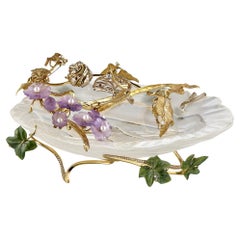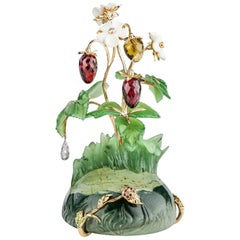Gold Figurines and Sculptures
to
10
162
122
52
49
44
33
19
14
12
12
4
21
43
53
1
1
2
4
2
9
4
4
3
110
11
1
25
10
9
7
6
to
25
6
3
3
2
32
10
5
5
4
4
4
1
1
1
1
121
1
50
40
Metal: Gold
18K Gold transforming jewellery Interior Object by Viktor Moiseikin
Located in Hong Kong, HK
All in this world is a reflection
Of divine love and eternal art.
And we're seeking inspiration,
In the feelings – strings of soul harps.
-Viktor Moiseikin -
The 'Serenity' interior decoration by MOISEIKIN is a beautiful combination of modern and traditional jewellery art. The large carved quartz jewel plate, in which you can place your jewellery, represents the water where the natural lives concentrate. Delicately carved Clematis leaves made of jade and gold gently as if embracing precious pure water. The golden fluttering butterfly and snail are embedded with precious gems that bring charm. One beautiful and shining moment of nature is precisely and artistically reflected in this gold and jewellery artwork...
Category
2010s Thai Artisan Gold Figurines and Sculptures
Materials
Amethyst, Diamond, Garnet, Jade, Cultured Pearl, Quartz, Sapphire, 18k G...
Price Upon Request
18 Karat Gold Flower Miniature Precious Berries by MOISEIKIN
By MOISEIKIN
Located in Hong Kong, HK
Gold floral compositions with precious or semi-precious stones or enamel became popular at the turn of the 20th century in Europe and Russia. Especially Imperial families and nobilities collected or gifted to important people.
The flowers are carved from cacholong —Russian milky opals — look so tender and natural.
Berries are skillfully cut from citrine and garnets. Golden stems are carved lively and embedded with rare Ural demantoid garnets. Fresh nephrite leaves are carved by hands. The intricate dewdrop is intricate.. embedded with diamonds.
On a green jasper ground, a lucky ladybug made of gold, rubies and black diamonds is enjoying the moment.
Perfectly expressed in the precious metal and stones by skillful craftsmen of MOISEIKIN®, the pleasant memory will not fade away.
This flower miniature is one of Precious Berry Collections and another piece is possessed by a known royalty who collects flower...
Category
21st Century and Contemporary Russian Contemporary Gold Figurines and Sculptures
Materials
Citrine, Diamond, Garnet, Jade, 18k Gold
Price Upon Request
Still Thinking About These?
All Recently ViewedMore Ways To Browse
Royal Worcester Horses
Sterling Silver Horse Figurines
Calla Lily Brooch
Cameo Stick Pin
Cartier Bow
Cartier Les Delices De Goa
Cartier Pearl Brooch
Cento Diamond
Chanel Brooch Diamond
Chanel Gripoix 1969
Chanel Vintage Turn Lock
Chaumet Ruby
Chinese Enamel Brooch
Chopard Blue Sapphire
Christian Dior Perfume
Christian Dior Swarovski
Ciro Jewelry Vintage
Ciro Jewelry

